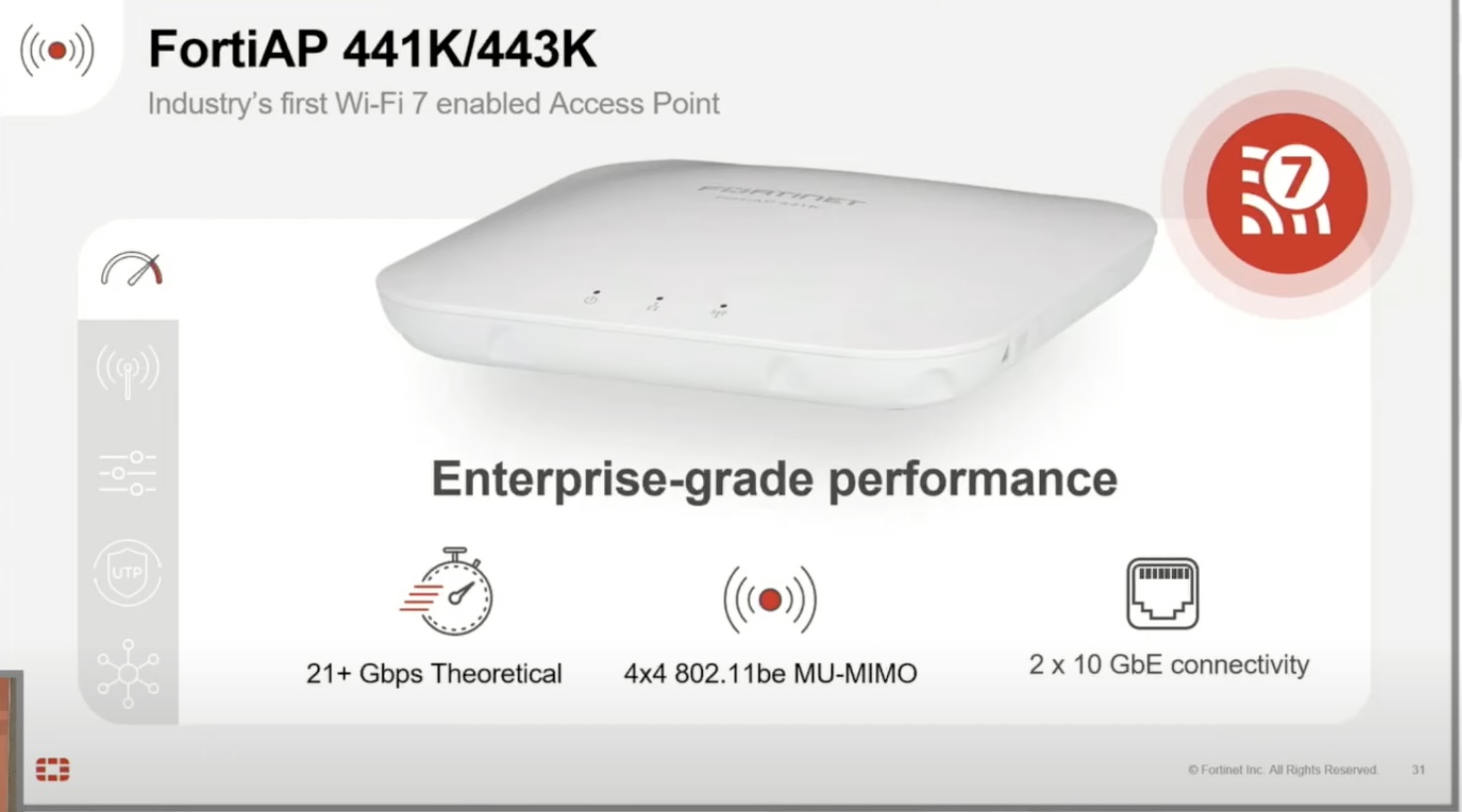Not too long ago users upgraded to Wi-Fi 6E tapping into significant speed and performance upgrades from the previous standard. As 2024 rolled in, the 7th generation debuted bringing with it promises of even faster connections and ultra-low latency.
There is a lot of noise and excitement around it, and for good reason. Wi-Fi 7 marks a major milestone in the evolution of connectivity. Not only is it fourfold faster than Wi-Fi 6 and 6E, and can support a lot more devices and connections, the new standard also packs a lot of clever upgrades.
At the recent Mobility Field Day event in California, Fortinet showcased the FortiAP K-series, their line of Wi-Fi 7-enabled access points (APs).
One of the industry’s first to launch APs supporting Wi-Fi 7’s bandwidth, Fortinet has been at leading edge of technology for years providing enterprises smart and secure connectivity.
From the outset, Fortinet has been a big proponent of security-driven networking. The converged networking and security approach has many benefits. “More than 50% of our global shipments are all firewalls. The same firewall can also be a wireless controller, switch controller, or the extended controller. There are a lot of options enabled for no additional cost. For a business case, it translates to lower cost of ownership because it is all integrated.” says Sumanth Gorajala, Senior Director of Wireless Product Management.
For Wi-Fi 7, the vision is the same, but to bring it the edge with security-enabled wireless devices. The idea is to provide intelligent and secure connectivity for everybody from top to bottom, says Gorajala.
Notable Wi-Fi 7 Upgrades
The biggest factor about Wi-Fi 7 that distinguishes it from its predecessors is that it offers more lanes and highways. What does that mean for users? Simply put, the 7th generation offers four times faster speeds and improved latency than Wi-Fi 6E.
There are some clever manipulations at work here. Cellular networks transmit data through radio waves. The waves travel at varying frequencies and are grouped into bands. Each band comprises of multiple channels. For example, the 2.4-GHz band has 11 channels of 20 MHz each. Wi-Fi 7 uses three bands – 2.4-GHz, 5-GHz and 6-GHz. In the 6GHz band, these channels expand to up to 320 MHz. With three such ultra-wide channels on a dedicated 6-GHz band, the available bandwidth is twice that of the previous generation.
A modulation scheme used for sending and receiving data in Wi-Fi communications is Quadrature amplitude modulation or QAM. The potential benefit of that is to be able to embed more data in each signal. Wi-Fi 6E supports 1K-QAM, which Wi-Fi 7 upgrades to 4K-QAM. The difference is a jump of 20% in data rate.
Typically Wi-Fi standards establish connections between devices strictly on a single band. For the first time, Wi-Fi 7 presents multi-link operation (MLO), a capability that averts bottlenecks and enables efficient movement of data by intelligently choosing the best channel. Instead of devices connecting over a fixed channel on one band, MLO can decide to use multiple frequencies concurrently. The decision is made by the router while connecting with a Wi-Fi 7 device.
FortiAP 441K and 443K
Gorajala showcased FortiAP models – 441K and 443K, both high-performance enterprise-grade indoor Wi-Fi 7 APs with same specs list.
With support for all the aforementioned Wi-Fi 7 features and access to all the three bands – 2.4GHz, 5GHz and 6GHz, the FortiAP 441K and 443K are among the industry’s first Wi-Fi 7 APs.
It packs four radios, three for the three bands, and a fourth dedicated to security. “We have moved the dirty job from the three servicing radios to the fourth so that it can dedicatedly do scans, look for rogue APs and clients, detect sweeps and so on. All that will be done on the fourth radio.”

The devices have two 10 GbE ports that can be aggregated to get a combined speed of 21 Gbps, or used individually.
All the K-series models have Unified Threat Protection (UTP) enabled on the device. The UTP module includes capabilities like antivirus, intrusion prevention, application control, web filtering and anti-bot net.
“Everything will be on the app level so that when the wireless client connects with this feature enabled, all the traffic goes through the IPS engine and then passed on to the Ethernet side of it,” he explains.
Users also has the option to port from one Fortinet management solution to another as their needs change. Whether it is FortiOS, FortiLAN Cloud, or FortiSASE, users can manage, automate and orchestrate devices equally from all platforms.
“The same wireless AP can be managed by any of the solutions. It is easily portable, and as your business needs grow, you can move from one management solution to another with ease,” says Gorajala.
Wrapping Up
Wi-Fi 7’s extreme throughput and super-low latency can power the most bandwidth-intensive and low-latency applications. When considering switching, enterprises must look at access points that are not just Wi-Fi 7-supported, but also come with capabilities to tap into the technology’s most significant enhancements. At the same time, setting-up should be easy and quick. Fortinet’s access points look ready meet Wi-Fi 7’s throughout demands, while offering the added aspect of security and management for seamless connectivity.
Be sure to check out the demo at the end of the video and other presentations by Fortinet from the Mobility Field Day event.

